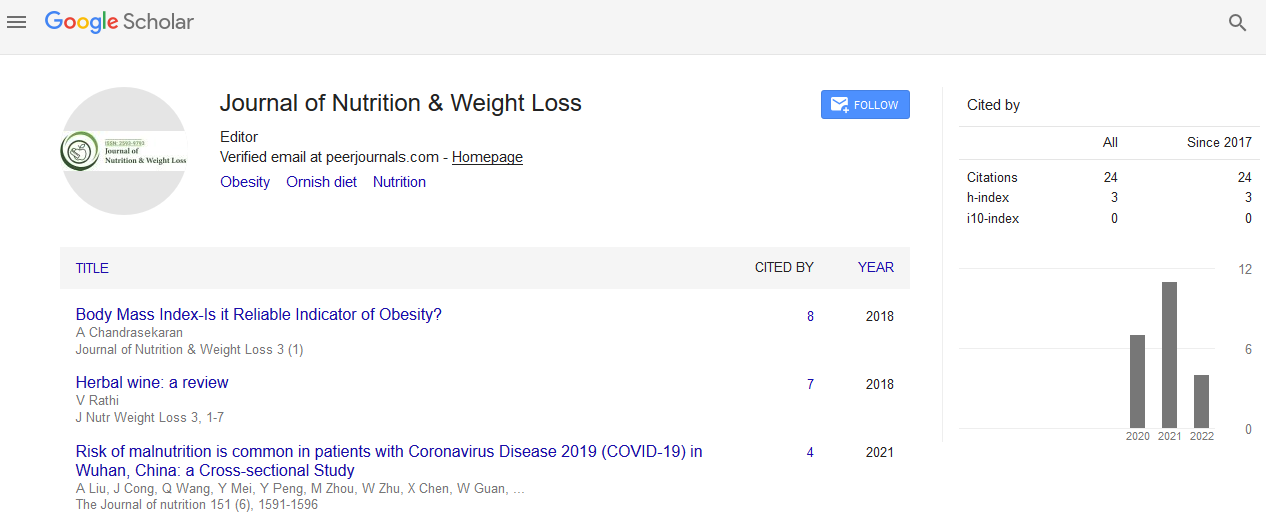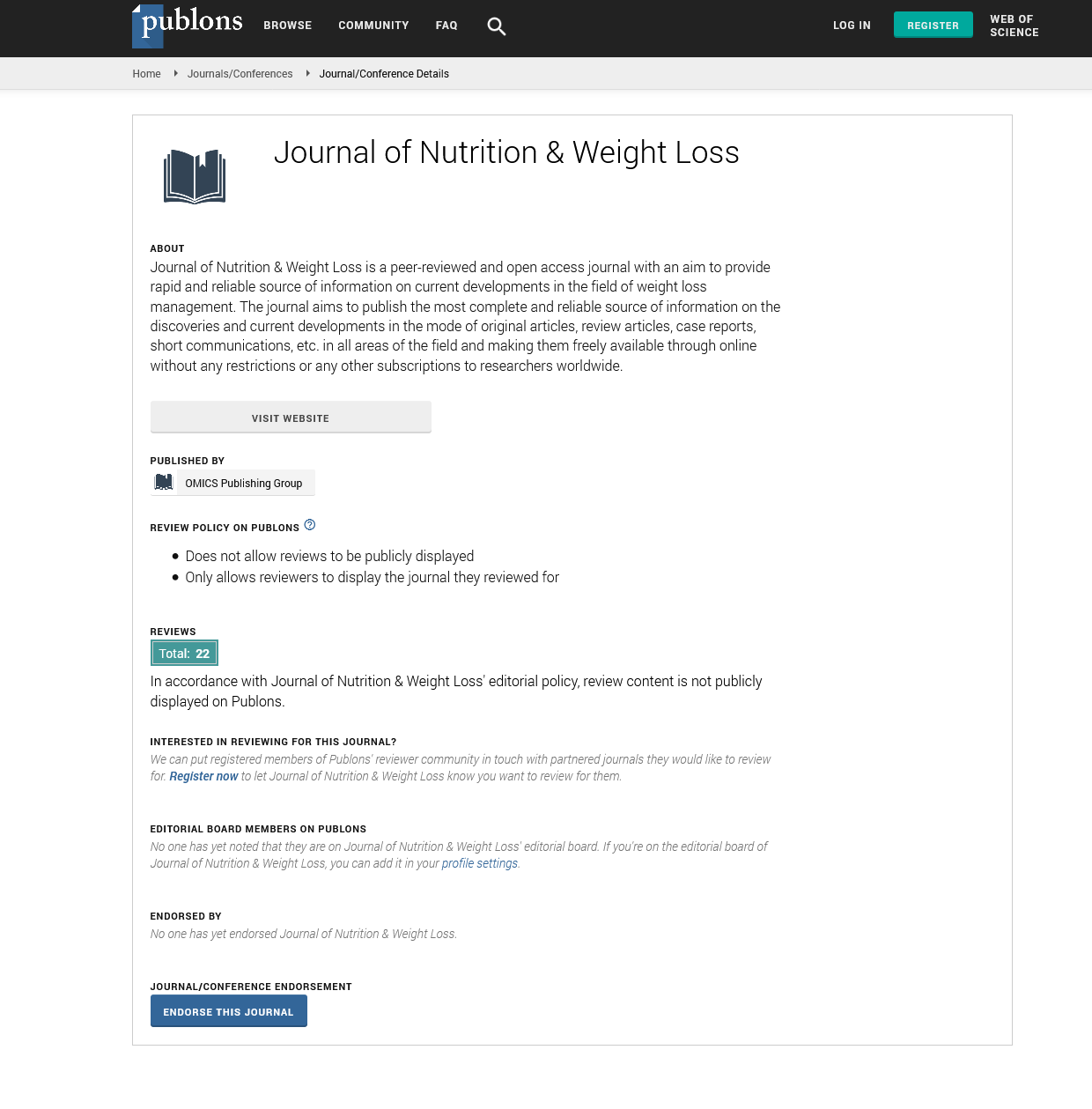Indexed In
- RefSeek
- Hamdard University
- EBSCO A-Z
- Publons
- Euro Pub
- Google Scholar
Useful Links
Share This Page
Journal Flyer

Open Access Journals
- Agri and Aquaculture
- Biochemistry
- Bioinformatics & Systems Biology
- Business & Management
- Chemistry
- Clinical Sciences
- Engineering
- Food & Nutrition
- General Science
- Genetics & Molecular Biology
- Immunology & Microbiology
- Medical Sciences
- Neuroscience & Psychology
- Nursing & Health Care
- Pharmaceutical Sciences
Perspective - (2023) Volume 8, Issue 1
BMI (Body Mass Index): Clinical Analysis in Visceral Adiposity
Yuetong Maruyama*Received: 21-Feb-2023, Manuscript No. JNWL-23-20962; Editor assigned: 24-Feb-2023, Pre QC No. JNWL-23-20962(PQ); Reviewed: 14-Mar-2023, QC No. JNWL-23-20962; Revised: 21-Mar-2023, Manuscript No. JNWL-23-20962(R); Published: 28-Mar-2023, DOI: 10.35248/2593-9793.23.8.156
Description
Body Mass Index (BMI) is the measure of body fat that is based upon height and weight that applies to adult men and women. It is used as a general indicator, whether a person has a healthy body weight for their height. BMI can be calculated using standard or metric units, and there are different categories of BMI depending on the value obtained. A high or low BMI can increase the risk of various health problems such as:
• Increases risk of heart disease, stroke, and high blood pressure.
• Increased risk of type 2 diabetes and blood clots.
• Increases risk of certain types of cancer.
• Increased risk of sleep apnea and metabolic syndrome.
• Increased risk of arthritis, gallbladder disease, fatty liver disease, and infertility.
• These health risks may be reduced by lowering the BMI rate through healthy lifestyle changes.
The association of Body Mass Index (BMI) has been studied in various contexts, such as outcomes following groin hernia repair, outcomes in ischemic stroke, changes in DNA methylation, cognitive function in older populations, and relations to cardio metabolic disease. BMI can be reduced by changing the diet and being more physically active. Set realistic goals and aim for losing 5% of the weight at a time. Self-monitor of weight, exercise, and calorie intake. Eat a healthy diet with more fruits, vegetables, whole grains, lean proteins, and low-fat dairy products. Cut back on sugar, processed foods, and sweetened beverages. Obesity is a health concern due to an abnormal or excessive accumulation of fat and BMI of 30 or greater is the threshold for it. Based on the BMI measurement, there are three further classifications of obesity. Numerous illnesses and health issues, including type 2 diabetes, heart disease, stroke, cancer, sleep apnea, metabolic syndrome, arthritis, gallbladder disease, fatty liver disease, and infertility, can be made worse by obesity. Some environmental factors that may affect physical activity and BMI are the accessibility and availability of healthy food options, includes organic food, farmers' markets, and supermarkets. Living in a food desert, where there is little availability of affordable, wholesome food may make more likely to become obese. The neighborhood’s accessibility and safety, including things like sidewalks, bike lanes, parks, green areas, and public transportation. More physical activity and a lower BMI may result from being in a community that is more walkable. The aspects of the workplace that enable exercise breaks, such as stair access, parking, gym facilities, and policies. A more accommodating workplace might encourage greater exercise and a lower BMI. The context of family includes parental modelling, encouragement, and support of physical activity. Having a supportive family may foster more physical activity and lower BMI in children and adolescents.
Conclusion
Underwater weighing measurements of body fat % and BMI typically have lower correlation coefficients than De-oxy Ribose Nucleic Acid (DNA) measurements of the same variables. The difference in the strength of the correlations could mean that DNA gives a more accurate measurement of total body fat in children and adolescents than underwater weighing does, or it could mean that the assumptions used to calculate total body fat from underwater weighing are erroneous. The connection coefficients between percentage body fat and BMI appear to be similar in young boys and girls and lower in older males than older girls based on the DNA results. According to the one study that looked at patients according to puberty stages, mature boys had less body fat than mature girls at equal BMIs.
Citation: Maruyama Y (2023) BMI (Body Mass Index): Clinical Analysis in Visceral Adiposity. J Nutr Weight Loss. 8:156.
Copyright: © 2023 Maruyama Y. This is an open-access article distributed under the terms of the Creative Commons Attribution License, which permits unrestricted use, distribution, and reproduction in any medium, provided the original author and source are credited.


